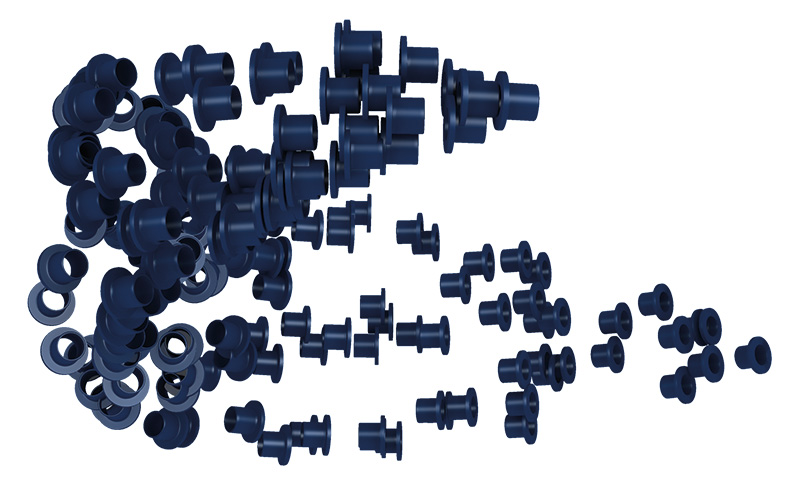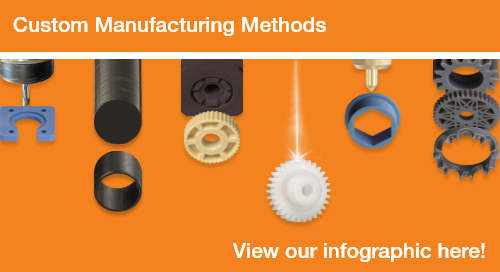3 Ways to Reduce Costs of Injection-Molded Parts
The design rules for the most cost-effective injection molding designs apply to plain bearings in particular, to wear parts in general and to all other components. The pressure to cut costs is particularly high for plain bearings and wear parts. As “disposable parts”, they should last as long as possible but also cost as little as possible. Buyers haggle over every penny in order to reduce the cost of injection molded parts. One important aspect is usually completely overlooked: the component design and its effects on the costs of the injection mold and the production time. So let's take a look at the cost drivers.
Cost of Injection Molded Parts: The Injection Mold

Injection molding is a fantastic manufacturing method for producing large quantities of similar components. The proverbial block on the leg is the injection mold. While the idea is basically the same as with the mold in the sandpit, the injection mold is often very complex. So-called undercuts or other special component shapes require small wipers or locking parts that subsequently block or detach certain points.
In addition, with a single “open-close-open” process, several parts should often fall out of shape at once. And since all forms are a 3-dimensional mirror image - the so-called negative - the production of injection molds is often very complex. This complexity, coupled with the fact that injection molds are often custom-made, drives costs extremely high. After all, the manufacturer of the mold has to calculate all the costs for the conception and programming of the machining process, as well as the set-up and production costs, on the one copy. Then there is the material from which the injection mold is made. The injection mold wears out with every production process. The more wear-resistant the material, the more expensive it is.
Tip 1: Simplify the Shape of Your Injection-Molded Part
The simpler the shaping, the lower the complexity of the injection mold. In practice, an undercut that is just a few millimeters too large for axial securing can turn a ~$2,433 injection mold into a ~$4,866 injection mold. Avoid excessively protruding undercuts or other shape features that could get in the way when separating the two halves of the negative mold. If possible, protruding features should lie along the same axis.
Injection Molded Part Costs: The Cycle Time
Cycle time is the time that elapses between closing the injection mold and opening and ejecting the finished part. A lot happens in between. The liquid plastic is injected, fills the "cavity" - i.e. the negative impression of the component, cools down and is finally ejected. The longer this process takes, the longer the production time of the entire order. A reduction in this production time brings corresponding savings.
Tip 2: Avoid Complex and Thick-Walled Areas
The longer the plastic takes to fill the entire part and the thicker the cross-section of the molds, the longer it takes for the material to reach all points in the cavity and to cool sufficiently.
Cost of Injection Molded Parts: The Material
First and foremost, of course, the procurement price of the material decides the part price, but also the nature of the material to be processed. Why? Because the material used has an impact on the wear and tear of the injection mold. Plastics with a high glass fiber content have an abrasive effect on the surface of the injection mold. Accordingly, it takes less time for the necessary repairs or even new production. In addition, the thermal properties of the material can in turn affect the cycle time mentioned.
Tip 3: Use Inexpensive and Easy-to-Process Materials Whenever Possible
Of course, in many applications there is no getting around higher-priced materials. Nevertheless, it makes sense to question the requirements placed on the component and to select the appropriate material accordingly. It is not uncommon for plastics to be selected primarily because one has already had good experiences with them, or because it was “just given”. Also question the durability of the injection mold. Depending on the component material used and the number of pieces required, an injection mold made of aluminum or even plastic is often sufficient instead of expensive hardened steel.
Let us help you design custom bearings out of our high-strength iglide® plastic materials. Our experts will determine the most efficient manufacturing method and the ideal plastic material to meet your specific requirements. Visit our webpage to get started today.



